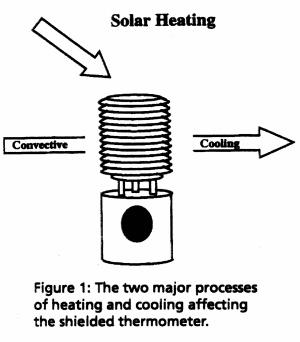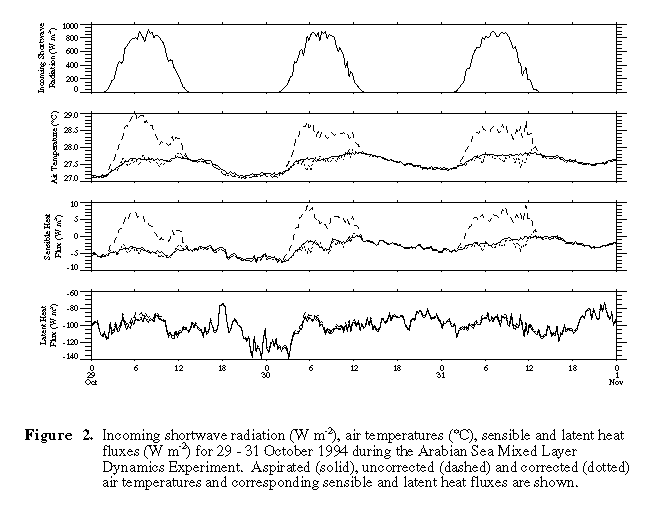
Both a shielded and an aspirated platinum resistance thermometer were deployed along with a suite of meteorological and oceanographic instrumentation on a 3m discus buoy at 15 30'N, 61 30'E during the Arabian Sea Mixed Layer Dynamics Experiment. The experiment was conducted in two sequential moorings at the same location, the first of which was deployed from 15 October 1994 to 20 April 1995 (Arab 1) and the second from 22 April to 20 October 1995 (Arab 2). The pump on the aspirated thermometer operated for 59 and 51 days during Arab 1 and Arab 2, respectively, before depleting its limited power supply. The aspirated thermometer was included in the design of this experiment to provide accurate air temperatures under expected low wind conditions early in the deployment. Due to the availability of simultaneous aspirated and shielded temperature measurements, a correction for the shielded thermometer was sought to account for the heating and cooling of the radiation shield. A simple model which predicted the heating and cooling of the shielded thermometer was developed based on a comparison of the aspirated and non-aspirated temperature measurements. This model accounted for the major heating and cooling processes affecting the shielded thermometer (depicted in Figure 1) based only on the incoming solar radiation, wind speed, wind direction relative to the buoy and sun angles.

Solar heating of the radiation shield was estimated as the product of the incoming shortwave radiation (measured on the mooring by a pyranometer) and the surface area exposed to the sun (a function of the sun's elevation angle and the shield geometry). Convective cooling is the rate at which the shield was cooled due to air flow over it and was estimated using the difference between the shielded and aspirated temperatures, the surface area of the shield and the convective heat transfer coefficient. Since the convective heat transfer coefficient is the only unknown in the model while the aspirated thermometer was operating and since this coefficient is conceptually related to wind speed, a function for the convective heat transfer coefficient was determined based on the observed wind speed. Solar shading and wind blocking by other instruments on the buoy were incorporated in the model with reasonable success.
During Arab 1, a correction based on the model reduced the average absolute difference between the shielded and aspirated thermometer by 0.20C or 60%. The average absolute difference between the best available sensible heat flux measurement (the sensible heat flux computed using the aspirated temperature) and the sensible heat flux computed from the shielded air temperature was reduced by 1.65W/m^2 or 60% while the latent heat flux was reduced by 1.18W/m^2 or 35%. The air temperatures and corresponding sensible and latent heat fluxes for the uncorrected, aspirated and corrected time series are shown in Figure 2. This period was characterized by moderate winds (4 - 6m/2) and strong insolation.

While this correction seems to reduce large solar heating errors, there are a few factors or processes that are not taken into account. The correction depicted in Figure 2 does not incorporate the complex geometry of the shield, but simply assumes that heat transfer is occurring over a perfect cylinder. The ventilated design of the shield is difficult to simulate in a physical model and will certainly allow more convective cooling when compared to the perfect cylinder. Another difficult factor to correct is the shading of the shielded thermometer by objects around it. Shading is incorporated in the model only as a function of solar azimuth angle relative to the buoy while shading is clearly a function of both the solar azimuth and solar elevation. A correction based on these two sun angles is very difficult to determine and implement. The approach adopted in the model is only a partial solution.
Directed experiments to measure the effects of the ventilated geometry and shading are possible, however the preferred solution would be to develop a low power aspirated thermometer to replace the shielded thermometer for the entire duration of a mooring. Presently, the corrections applied to the shielded temperatures during the Arabian Sea experiment reduce the errors due to solar heating, thereby improving the estimation of sensible and latent heat fluxes.
The Arabian Sea Mixed Layer Dynamics Experiment was funded by the Office of Naval Research under Grant No. N00014-94-1-0161.
Mark Baumgartner is a Research Assistant in the Physical Oceanography Department and a member of the Upper Ocean Processes Group at the Woods Hole Oceanographic Institution.
 Return to UOP Homepage
Return to UOP Homepage